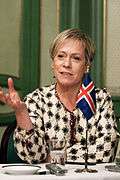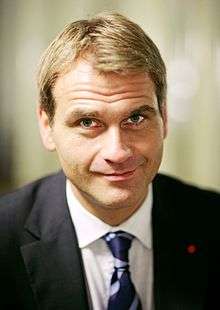Social Democratic Alliance
The Social Democratic Alliance (Icelandic: Samfylkingin jafnaðarmannaflokkur Íslands), officially The Alliance – Iceland's Social Democratic Party, is a social-democratic,[4][5][6] feminist[2] and pro-European[3] political party in Iceland.
Social Democratic Alliance Samfylkingin | |
|---|---|
| Chairperson | Logi Már Einarsson |
| Vice-chairperson | Heiða Björg Hilmisdóttir |
| Chairperson of the board | Inga Björk Margrétar Bjarnadóttir |
| Secretary of the board | Þórarinn Snorri Sigurgeirsson |
| Chairperson of the parliamentary group | Oddný Harðardóttir |
| Founded | 5 May 2000 |
| Merger of | National Awakening People's Alliance Social Democratic Party Women's List |
| Headquarters | Hallveigarstígur 1 101, Reykjavík |
| Youth wing | Social Democratic Youth |
| Ideology | Social democracy[1] |
| Political position | Centre-left[2][3] |
| European affiliation | Party of European Socialists (associate) |
| Nordic affiliation | SAMAK The Social Democratic Group |
| Colours | Red |
| Seats in Parliament | 7 / 63 |
| Election symbol | |
| S | |
| Website | |
| samfylkingin | |
The Social Democratic Alliance was founded in 2000 at the convergence of four centre-left political parties (the National Awakening, the People's Alliance, the Social Democratic Party and the Women's List) following a joint run by all parties in the 1999 Icelandic parliamentary election. The vision of the party was to unite the left-wing of Icelandic politics which was fractured since the 1930 split of the Social Democratic Party and present a united bloc to oppose the ruling Independence Party.
In the snap 2009 Icelandic parliamentary election called in the aftermath of the Icelandic financial crisis, the Social Democratic Alliance under the leadership of Jóhanna Sigurðardóttir emerged as the largest party and formed a coalition government with the Left-Green Movement which became the country's first majority left-wing government. The party lost substantial support in the 2013 Icelandic parliamentary election, becoming the third largest in Alþingi and nearly losing all its representatives at the 2016 Icelandic parliamentary election, where it polled 5.7%.[7] The party then regained support in the 2017 Icelandic parliamentary election under the leadership of chairperson Logi Már Einarsson, again becoming the third largest party and largest opposition party.
In 2014 it became the largest party in the Reykjavík City Council[8], and party member Dagur B. Eggertsson became mayor[9]. As of 2018 it is the second largest party in the City Council after the Independence Party[10] but remains in a majority coalition with Dagur as mayor[11].
History
The Social Democratic Alliance was born in the run-up to the 1999 Icelandic parliamentary election as a political alliance of the four left-wing political parties that had existed in Iceland up till then, namely the National Awakening, the People's Alliance, the Social Democratic Party and the Women's List.[12]
The parties then formally merged in May 2000 under the name The Alliance (Samfylkingin). The merger was a deliberate attempt to unify the entire Icelandic centre-left into one political party capable of countering the centre-right Independence Party. However, the initial attempt failed as a group of Althing representatives rejected the new party's platform which was inspired by that of Tony Blair's New Labour and broke away before the merger to found the Left-Green Movement, a party based on more traditional democratic socialist values as well as Euroscepticism and green politics. The Icelandic Movement – Living Country merged into the party in March 2009.[13]
In February 2013, the official name of the party was changed to The Alliance – Social Democratic Party of Iceland (Icelandic: Samfylkingin – Jafnaðarmannaflokkur Íslands).[14]
The chair of the party is Logi Már Einarsson, who was elected as vice-chairman in June 2016. Oddný Guðbjörg Harðardóttir was elected as chair of the party to succeed Árni Páll Árnason in June 2016, but he resigned after the results the 2016 Icelandic parliamentary election. The youth wing of the Social Democratic Alliance is the Social Democratic Youth.
Electoral results
| Election | Votes | % | Seats | +/– | Position | Government |
|---|---|---|---|---|---|---|
| 1999 | 44,378 | 26.8 | 17 / 63 |
Opposition | ||
| 2003 | 56,700 | 31.0 | 20 / 63 |
Opposition | ||
| 2007 | 48,743 | 26.8 | 18 / 63 |
Coalition | ||
| 2009 | 55,758 | 29.8 | 20 / 63 |
Coalition | ||
| 2013 | 24,292 | 12.9 | 9 / 63 |
Opposition | ||
| 2016 | 10,893 | 5.7 | 3 / 63 |
Opposition | ||
| 2017 | 23,652 | 12.1 | 7 / 63 |
Opposition |
Leadership
| Nº | Chairman | Took office | Left office | |
|---|---|---|---|---|
| 1 |  |
Margrét Frímannsdóttir (1954) |
1999 | 2000 |
| 2 | .jpg) |
Össur Skarphéðinsson (born 1953) |
2000 | 2005 |
| 3 |  |
Ingibjörg Sólrún Gísladóttir (born 1954) |
2005 | 2009 |
| 4 | .jpg) |
Jóhanna Sigurðardóttir (born 1942) |
2009 | 2013 |
| 5 |  |
Árni Páll Árnason (born 1966) |
2013 | 2016 |
| 6 |  |
Oddný Guðbjörg Harðardóttir (born 1957) |
2016 | 2016 |
| 7 |  |
Logi Már Einarsson (born 1964) |
2016 | Present |
Parliamentary party
| Member | Since | Further information | Constituency |
|---|---|---|---|
| Logi Már Einarsson | 2016 | Party leader | Northeast |
| Albertína Friðbjörg Elíasdóttir | 2017 | Northeast | |
| Oddný G. Harðardóttir | 2009 | Chair of the parliamentary party[15] | South |
| Guðjón S. Brjánsson | 2016 | First Assistant Speaker of the Parliament[15] | Northwest |
| Ágúst Ólafur Ágústsson | 2017 | Previously a Member of Parliament from 2003–2009 | Reykjavik South |
| Helga Vala Helgadóttir | 2017 | Reykjavik North | |
| Guðmundur Andri Thorsson | 2017 | Vice-chair of the parliamentary party[15] | Southwest |
References
- Nordsieck, Wolfram (2017). "Iceland". Parties and Elections in Europe.
- The Reykjavík Grapevine's Election Guide 2013 (scanned version) (Html version
- Vucheva, Elitsa (28 January 2009). "Iceland's centre-left to form new government". EUobserver. Retrieved 28 March 2019.
- Hans Slomp (30 September 2011). Europe, A Political Profile: An American Companion to European Politics. ABC-CLIO. p. 680. ISBN 978-0-313-39182-8. Retrieved 22 August 2012.
- Claire Annesley (11 January 2013). Political and Economic Dictionary of Western Europe. Routledge. p. 18. ISBN 978-1-135-35547-0. Retrieved 13 July 2013.
- Åsa Bengtsson; Kasper Hansen; Ólafur Þ Harõarson; Hanne Marthe Narud; Henrik Oscarsson (15 November 2013). The Nordic Voter: Myths of Exceptionalism. ECPR Press. p. 209. ISBN 978-1-907301-50-6.
- "Social Democrats nearly wiped out in Iceland's election; Nordic Labour Journal". nordiclabourjournal.org. 7 November 2016. Retrieved 14 November 2016.
- https://www.visir.is/g/2014140609957/lokatolur-i-reykjavik--meirihlutinn-fallinn
- https://reykjavik.is/borgarfulltruar/dagur-b-eggertsson
- https://www.mbl.is/frettir/kosningar/svf_results/
- https://reykjavik.is/frettir/nyr-meirihluti-i-borginni-kynntur-vid-breidholtslaug
- Julia Kaute (2 December 2010). Warming up for the EU: Iceland and European Integration: An Analysis of the Factors Contributing to the Changing Perception of Iceland’s Political Elites Toward Membership in the European Union. GRIN Verlag. p. 45. ISBN 978-3-640-76745-8. Retrieved 22 August 2012.
- "Major political party conferences underway in Iceland | IceNews - Daily News". Icenews.is. 29 March 2009. Retrieved 1 August 2014.
- Ísland. "Nafni Samfylkingarinnar breytt | RÚV". Ruv.is. Retrieved 1 August 2014.
- Alþingi. "Þingflokkur Samfylkingarinnar". Retrieved 9 January 2018.
External links
- Official website (in Icelandic)